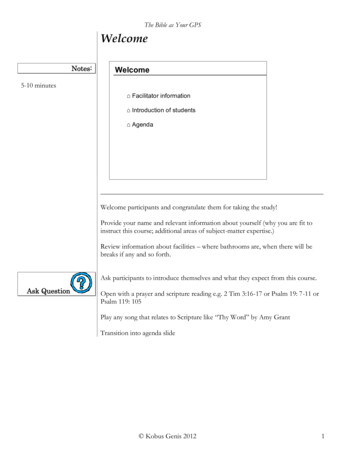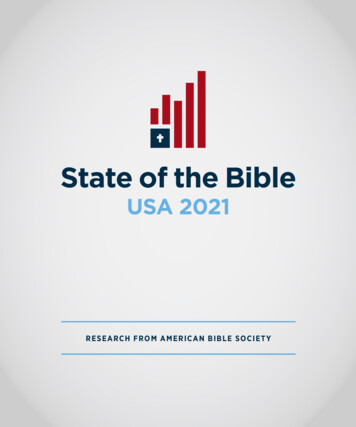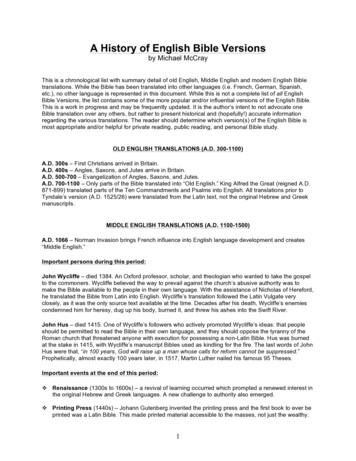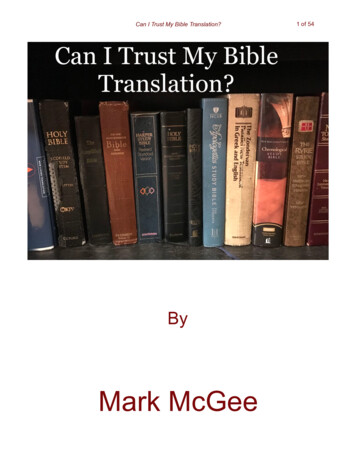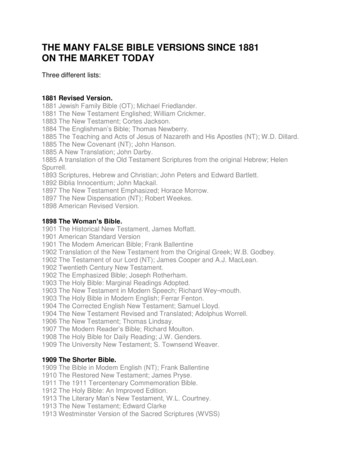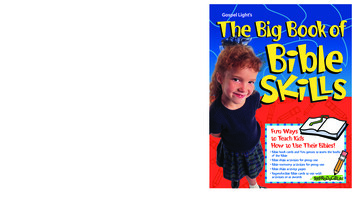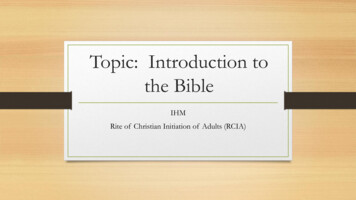
Transcription
Topic: Introduction tothe BibleIHMRite of Christian Initiation of Adults (RCIA)
In the name of the Father, and theSon, and the Holy Spirit, Amen.OpeningPrayer“Bless us, O Lord, and these thygifts, which we are about toreceive. From thy bounty, throughChrist our Lord, Amen.”
Guest SpeakerFr. Ralph Thomas, IHM
What is theBible,Theologically?
Scripture as DivineRevelation God’s self-communication revealing to us what God wants to tell us of faith and salvation.“As prayer is the voice of [human beings] to God, so [divine] revelation is thevoice of God to [human beings].”—Cardinal John NewmanCatholics are “nourished and ruled” by the Scriptures.The Liturgy (Mass) flows from Scripture; including the Lectionary (the bookcontaining the readings for Mass).Over the course of the 3-year Sunday & 2-year Weekday Cycle: 13.5 percent of the Old Testament (not counting the Psalms)54.9 percent of the non-Gospel New Testament89.8 percent of the Gospels71.5 percent of the entire New Testament
Who is the Author ofScripture? Both God and humans are truly the author. Divine Inspiration God the Holy Spirit truly inspired the authorsof sacred scripture what to write in regards to our salvation. However the Holy Spirit did not “override” the human natureof the author—they kept full use of their human knowledgeand creativity. Biblical inerrancy the books of sacred scripture are without errorin regards to conveying the “truths of salvation.” Human author’s limitations in science, geography, etc. remain;as well as cultural biases and assumptions.
How do we interpret the Bible contextually? Exegesis (‘out of the beginning’): Explaining the original meaning, then applying that meaning to our context Language, words, genre, culture, author, editors, audience Tools for exegesis: Footnotes and References Concordance (list of words) Commentary Literary Forms (genres); Different styles of writing must be understood differently Biblical Archaeology Analogy of Faith: connectedness of one doctrine with the rest of Divine Revelation Online NAB Catholic Bible with commentary, footnotes and searchable concordance: http://www.vatican.va/archive/ENG0839/ INDEX.HTM
Biblical Exegesis ChartType ofMethodDescriptionQuestions This Method AsksTextualCriticismScholars attempt to recover themost original version of biblicalbooks, because no originals exist,only copies. These scholarscompare different translations of theScriptures to understand moreclearly the meaning of a givenpassage. Of the many ancient copies and fragments ofBible books, which ones are the oldest?Scholars work to uncover thehistorical situation, or Sitz im Leben,of the writer at the time a particularbook or story was written. What was the historical situation during the life ofthe author / editor or of the author / editor’scommunity?Scholars look at the Scriptures andseek to understand them as a workof literature. Did the writer use a particular literary form ordevice such as a poem, a historical story, aprophecy, a letter, or a gospel?HistoricalCriticismLiteraryCriticism Can we identify why there are differencesbetween different copies of the same book? Can we identify why different translations usedifferent words in passages? How did the historical situation influence theauthor’s writing? Did the passage use metaphors, puns, parables,exaggeration, a midrash, or other literarydevices? How did these particular literary forms or devicesfunction in an ancient society?SourceCriticismScholars attempt to identify if thebiblical authors used an existingstory, myth, or other literature as thebasis for their work. Are other writings from ancient cultures outsidethe Scriptures similar to a biblical passage? What is the meaning of the differences betweenthe way a story is told in the Bible and the way itis told in other sources?(This chart is adapted from the Saint Mary’s Press Essential Bible Dictionary, by Sheila O’Connell-Rousell [Winona, MN: SaintMary’s Press, 2005], page 57. Copyright 2005 by Saint Mary’s Press. All rights reserved.)
Composition of the Bible
How was the Bible written? Four-Step Process: Event/experience Something happened Oral tradition People talked about it Written tradition People wrote about it Redaction (Editing) People edited it
How long did it take to writethe Bible? The actual writing spanned about 1,100 years c. 1,000 BC – c. 100 AD The events were much longer ( 1850BC-100AD) Many books in the Old Testament were writtenhundreds of years after the actual eventsoccurred. Most books do not occur in chronological order.
How was the Canon of the Bible determined? Canonical- part of the canon (“standard/rule”) Canon: the collection of books the Church recognizes as inspired by GodOld Testament Canon Already established by the time of Jesus (included Greek books Septuagint; after Judaism and Christianitysplit, Jews will reject the Greek books from their Canon—this is why Protestant and Catholic OT lists vary). These 7 books found in the Catholic, but not Protestant Bible, are called the Deuterocanonical (“2 nd canon”)books by Catholics and often Apocrypha (“hidden) by Protestants.New Testament Canon Four Standards: From apostles or their companions?Universally accepted by all Christians?Use of the text in Christian liturgy?Message consistent with rest of revelation?
Why are there differenttranslations? The first Bible was compiled in Latin by St. Jerome (late 4th c.-early 5th c.) The Vulgate, meaning “common” because it was translated into the commonlanguage of Latin. “Ignorance of the Scriptures is ignorance of Christ!” Any translation must decide between: Word-for-word translation (Formal Equivalency) or A translation of meaning (Dynamic Equivalency) The Bibles used by Catholics are in the middle: New American Bible (NAB) This is the version used in the Lectionary at Mass New Revised Standard Version (NRSV)
Structure of the Bible
Biblical Notation Bible from Greek “Biblios” Books Not a single book, but a library Divided into: Books, Chapters (13th c.), and Verses (16th c.) Colon divides chapters & verses Dash means “through” Comma means “and” Semicolon divides blocks of material * Footnotes Raised letter indicates reference to another Bible passage http://catholic-resources.org/Bible/Biblical References.htm
Two Major Divisions Old Testament/Covenant 46 books, originally written in Hebrew and Greek (some Aramaic)History of Israel and God’s first covenants with humanity“old” meaning first & foundational (NOT out of date/irrelevant)Jesus fulfills the OT; OT foreshadows the NTNew Testament/Covenant 27 books, originally written in GreekHistory of Jesus & early ChurchJesus as the fullness of salvationGod’s plan now clearly revealedWhile the OT are also the Hebrew Scriptures, both the OT & NT together are theChristian Scriptures (not merely NT)
The Old Testament 4 Categories: Torah/Pentateuch/The Law 1st 5 books; Creation, Patriarchs & Matriarchs, Exodus & Sinai Historical Books Jewish history; Judges & taking over promised land, kings & monarchy,etc. Wisdom Books Poetry, songs, witty sayings, short stories, etc. Prophetic Books Prophets calling out for justice and fidelity to God & the Covenant
The New Testament 4 Categories: Gospels Acts of the Apostles Life, ministry, teachings, Paschal Mystery of Jesus; central to the Christian faithHistory of the early ChurchLetters (Epistles) Pauline (by Paul) Deutero-Pauline (Disciple of Paul) Pastorals (for Church leaders) Catholic (Universal—to all)Revelation Apocalyptic literature
Discussion Questions Please share: What struck you from today’s Mass readings? How does a “contextualist approach” help us in understanding God’s Word? Catholics believe the Bible is authored by both God and humans; how does this belief guide us in ourunderstanding and interpretation of the Bible? How has Scripture been a part of your faith life, prior to RCIA? How might Scripture be more incorporated into your faith life, particularly as you explore becomingfully initiated into the Catholic Church? What questions did this topic and readings raise in your heart or mind?
Closing Prayerby St. John ChrysostomO Lord Jesus Christ,open the eyes of my heartthat I may hear your word,and understand and do your will,for I am a sojourner upon the Earth. On you do I set my hope, O my God,that you shall enlighten my mind and understandingwith the light of your knowledge;not only to cherish those things which are written,but to do them Hide not your commandments from me,but open my eyes,that I may perceive the wonders of your Law.For you are the enlightenment of those who lie indarkness,and from you comes every good deed and every gift.Amen.
Son, and the Holy Spirit, Amen. “Bless us, O Lord, and these thy gifts, which we are about to . New American Bible (NAB) This is the version used in the Lectionary at Mass New Revised Standard Version




